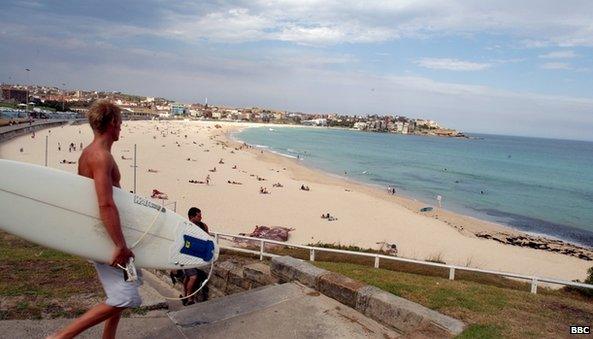Is Australia facing an obesity crisis?
- Published
Wendy Brownell, who is fronting an Australian health campaign, tells her story.
In her kitchen in a Sydney suburb, Wendy Brownell is preparing an afternoon snack for her two daughters.
"Yummy bananas," she says, trying to convince two-year-old Anneka as she slices up the fruit. Anneka doesn't look too sure.
Wendy, a pre-school teacher and mother of three, has struggled with her own weight for much of her life. She wants it to be different for her children, but things like fast food and advertising don't make it easy.
"My children and other children know the symbols for things like McDonalds and Coca Cola and Cadburys before they are two years old," she said.
"The truth is junk food is cheap and easy. With fast-food restaurants you don't even have to get out of the car, let alone buy food and cook it. It has just become such a part of our culture."
Around the world, Australia projects the image of a sporty, outdoorsy place full of fit people and open spaces.
But experts say unprecedented affluence along with a culture of convenience, growing portion sizes and an increasingly sedentary lifestyle have made one in two Australians overweight and turned the country into one of the fattest in the world.
While studies show that obesity rates in other developed countries like the US have begun to level off, Australia's are still on the rise.
Late last year, it climbed to fourth, external in the OECD's ranking of advanced nations with the largest proportion of obese citizens (28.3%), behind the US, Mexico and New Zealand.
And a study by the State of Victoria Department of Human Services predicted in 2008 that without effective intervention, 83% of men and 75% of women would be overweight or obese by 2025.
Professor Mike Daube, director of the Public Health Advocacy Institute, says other countries have moved more quickly to tackle obesity.
"We have an affluent, car-oriented, screen-dominated society where we eat as much as we like, we eat junk because it tastes good and it's quite cheap," he said.
"There is an immensely powerful food industry and the government hasn't even started to take action."
The government says it is trying to reverse that trend.
Kay McNiece, a spokesperson for the Australian Department of Health, says the government had committed A$932m to programmes and media campaigns targeting health education and promoting healthy choices. The government has also updated physical activity and dietary guidelines.
Initiatives are also taking place at state level, like in New South Wales - where officials say obesity cost the state A$19bn in 2008.
"We need to enable people to stay healthy and out of hospital in order to reduce these costs," Minister for Healthy Lifestyles Kevin Humphries said.
To that end, the NSW government has put A$186m into health initiatives including their centrepiece programme: Get Healthy, external.

Australia projects the image of a sporty country full of fit people
This is a free telephone coaching service that puts residents in touch with nutritionists and trainers to create a customised healthy eating and exercise plan.
Wendy Brownell has become one of the faces of a national advertising campaign that launched in January. She says the privacy of being able to get help over the phone and not having to see people was what made her call.
"I was depressed, I didn't want to go out. I was embarrassed about what I looked like and my doctor suggested Get Healthy because it's something personal. I could ring them and there was no one judging me," she said.
'Health literacy'
There is evidence that some government programmes - like the National Kitchen Garden programmes which encourages primary students to learn how to grow, harvest and cook fresh food - may be having an impact on children, whose obesity levels have levelled off in the past few years.
But overweight and obesity rates among adults have jumped by 1.5% countrywide in the past four years, with people in poor and remote areas reporting higher numbers.
Dr Lena Rodriguez of the University of Newcastle says high obesity rates in Australia's poorest communities and the health problems that go with them are creating a deep societal division.
"In essence we are creating two strands of society, it's diverging. Post World War II everyone was getting healthier - we had this equalisation. Now we are seeing a divergence."
She says in order to serve the whole population, education efforts need to be expanded into different communities to educate people according to their specific needs.
"It comes back to a class issue; it has worked very well for the middle class. If people have health literacy they understand why what they eat affects their health and why it's important to read the labels on what they buy," she said.
"But in some of these underserved areas you have very poor health literacy."
With nearly 11 million overweight Australians and obesity-related diseases on the rise, more serious measures are needed, says Prof Daube.
"You need tough, hard-hitting, long-term, sustained, well-funded media campaigns. We've had those with tobacco and HIV/AIDS and immunisation, but we haven't had those with obesity. If you look at what the government is doing, it's just soft stuff."
He says without any serious changes, he sees a bleak future.
"I am utterly, totally, pessimistic about the future of obesity for Australia. I think that that is just the way it's going to be and it's getting worse."
- Published13 January 2014
- Published9 January 2014
- Published13 January 2014